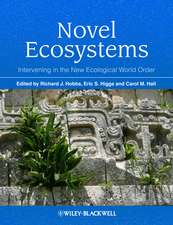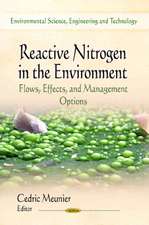Plant Nutrients in Desert Environments: Adaptations of Desert Organisms
Autor Arden D. Day, Kenneth L. Ludekeen Limba Engleză Paperback – 6 dec 2011
Din seria Adaptations of Desert Organisms
- 18%
 Preț: 954.14 lei
Preț: 954.14 lei - 18%
 Preț: 948.29 lei
Preț: 948.29 lei - 18%
 Preț: 945.92 lei
Preț: 945.92 lei - 18%
 Preț: 947.35 lei
Preț: 947.35 lei - 18%
 Preț: 1384.44 lei
Preț: 1384.44 lei - 18%
 Preț: 946.10 lei
Preț: 946.10 lei - 18%
 Preț: 1212.68 lei
Preț: 1212.68 lei - 18%
 Preț: 953.82 lei
Preț: 953.82 lei - 15%
 Preț: 632.70 lei
Preț: 632.70 lei - 15%
 Preț: 635.31 lei
Preț: 635.31 lei - 15%
 Preț: 639.25 lei
Preț: 639.25 lei - 15%
 Preț: 639.73 lei
Preț: 639.73 lei -
 Preț: 382.57 lei
Preț: 382.57 lei - 15%
 Preț: 636.80 lei
Preț: 636.80 lei - 15%
 Preț: 640.24 lei
Preț: 640.24 lei - 15%
 Preț: 641.03 lei
Preț: 641.03 lei - 15%
 Preț: 636.45 lei
Preț: 636.45 lei - 15%
 Preț: 637.28 lei
Preț: 637.28 lei -
 Preț: 378.92 lei
Preț: 378.92 lei - 15%
 Preț: 633.53 lei
Preț: 633.53 lei - 15%
 Preț: 693.71 lei
Preț: 693.71 lei - 15%
 Preț: 636.45 lei
Preț: 636.45 lei - 15%
 Preț: 641.53 lei
Preț: 641.53 lei -
 Preț: 388.34 lei
Preț: 388.34 lei -
 Preț: 395.63 lei
Preț: 395.63 lei
Preț: 632.37 lei
Preț vechi: 743.97 lei
-15% Nou
Puncte Express: 949
Preț estimativ în valută:
121.02€ • 125.02$ • 100.72£
121.02€ • 125.02$ • 100.72£
Carte tipărită la comandă
Livrare economică 26 martie-09 aprilie
Preluare comenzi: 021 569.72.76
Specificații
ISBN-13: 9783642776540
ISBN-10: 364277654X
Pagini: 132
Ilustrații: X, 117 p. 21 illus.
Dimensiuni: 155 x 235 x 7 mm
Greutate: 0.2 kg
Ediția:Softcover reprint of the original 1st ed. 1993
Editura: Springer Berlin, Heidelberg
Colecția Springer
Seria Adaptations of Desert Organisms
Locul publicării:Berlin, Heidelberg, Germany
ISBN-10: 364277654X
Pagini: 132
Ilustrații: X, 117 p. 21 illus.
Dimensiuni: 155 x 235 x 7 mm
Greutate: 0.2 kg
Ediția:Softcover reprint of the original 1st ed. 1993
Editura: Springer Berlin, Heidelberg
Colecția Springer
Seria Adaptations of Desert Organisms
Locul publicării:Berlin, Heidelberg, Germany
Public țintă
ResearchCuprins
1 Introduction.- 2 Plant Nutrients.- 2.1 Essential Plant Nutrient Elements.- 2.2 Effects of Plant Nutrient Elements on Plants.- 3 Soil Materials.- 4 Organic Soil Materials.- 4.1 Functions.- 4.2 Composition.- 4.3 Sources.- 4.4 Management.- 4.5 Maintenance.- 5 Soil Moisture.- 5.1 Field Capacity.- 5.2 Permanent-Wilting Percentage.- 5.3 Movement of Water.- 6 Soil Aeration.- 6.1 Composition of Soil Air.- 6.2 Soil Aeration and Plant Growth.- 7 Exchangeable Bases.- 7.1 Exchangeable Bases and Plant Nutrition.- 8 Soil Acidity.- 9 Soil Alkalinity.- 10 Nitrogen as a Plant Nutrient.- 10.1 Nitrogen in Soils.- 10.2 Nitrogen in Plants.- 10.3 Forms of Nitrogen Utilized by Plants.- 11 Phosphorus as a Plant Nutrient.- 11.1 Phosphorus in Soils.- 11.2 Phosphorus in Plants.- 11.3 Forms of Phosphorus Utilized by Plants.- 12 Potassium as a Plant Nutrient.- 12.1 Potassium in Soils.- 12.2 Potassium in Plants.- 13 Plant Nutrients in Desert Soils.- 13.1 Soils in the Yuma Subdesert.- 13.2 Man’s Invasion.- 13.3 How Desert Soils Differ.- 13.4 Minerals in Soils.- 14 Soil Moisture in Desert Environments.- 14.1 Soil Moisture Quantity.- 14.2 Soil Moisture Quality.- 15 Plant Nutrients Required for Growth.- 15.1 Plant Nutrients.- 15.2 Essential Elements in Plant Nutrition.- 16 Plant Nutrients in Municipal Wastewater.- 16.1 Municipal Wastewater Treatment.- 16.2 Irrigation with Municipal Wastewater.- 16.3 Future Prospects.- 17 Plant Nutrients in Sewage Sludge.- 17.1 Sewage Sludge Treatment.- 17.2 Plant Growth Factors in Sewage Sludge.- 17.3 Fertilization with Dry Sewage Sludge.- 17.4 Fertilization with Liquid Sewage Sludge.- 17.5 Future Prospects.- 18 Plant Growth in Desert Environments.- 18.1 The Dry Regions of the World.- 18.2 Climatic Factors Affect Plant Growth.- 18.3 Soil Fertility and ItsMaintenance.- 18.4 Fertilizer Use in Dry Regions.- 18.5 Crop Introduction and Improvement.- 19 Urban Utilization of Plant Nutrients.- 19.1 Plants in the Living Environment to Lift the Spirits of Man.- 19.2 Home Gardens Reduce Food Costs, Landscape Homesteads, and Improve Neighborliness.- 19.3 City Parks, Golf Courses, and Recreation Areas.- 20 Plant Nutrients for Disturbed Land Reclamation.- 20.1 Classification of Disturbed Lands.- 20.2 Reclamation Purposes and Alternatives.- 20.3 Spoil Replacement and Revegetation Techniques.- 20.4 Coal Mine Reclamation in Desert Areas.- 20.5 Vegetation Adaptability.- 21 Desert Environments Offer an Outstanding Future Potential.- 21.1 Technology Unlocks Cropland Productivity.- 21.2 Future Agricultural Research.- 21.3 Gardening for Food and Fun.- 21.4 Living on a Few Acres.- 21.5 Desert Environments Attract People.- Glossary of Agronomic Terms.- References.- Figure Index.- Fig. 1. Commercial agriculture in the desert area in Colorado, USA.- Fig. 2. Mixed vegetables grown in a small farm garden.- Fig. 3. A sand dune complex at the foot of mountains in Sangre de Christo, Colorado, USA.- Fig. 4. Plowing under sorghum stubble with a seven- bottom moldboard plow.- Fig. 5. Furrow irrigation in Texas, USA.- Fig. 6. An earthworm and earthworm castings in a fertile organic soil.- Fig. 7. Orange trees in Florida, USA growing in a fertile sandy loam soil.- Fig. 8. Planting corn and applying commercial fertilizers and soil amendments in the USA.- Fig. 9. Alkaline soil deposits in a desert area in California, USA.- Fig. 10. A stunted ear of corn caused by an extreme soil nitrogen deficiency.- Fig. 11. Surface application of inorganic fertilizer in Arizona, USA.- Fig. 12. Potassium-deficient corn in the USA.- Fig. 13. Native vegetation in a desert area in Arizona, USA.- Fig. 14. The Rio Grande River in Texas, USA.- Fig. 15. Side-dressing corn with anhydrous ammonia nitrogen fertilizer in the USA.- Fig. 16. Beef cattle grazing on an irrigated pasture in a desert area in Colorado, USA.- Fig. 17. Injection of liquid municipal sewage sludge into agricultural soil in the USA.- Fig. 18. Young citrus trees growing in a desert area in Arizona, USA.- Fig. 19. An outstanding home in a desert area in California, USA.- Fig. 20. Copper mine tailings that have been contoured to prevent wind erosion in Arizona, USA.- Fig. 21. A irrigated family farm in a desert area in the southwestern USA.- Fig. 22. A modern city established in a desert environment in the southwestern USA.










